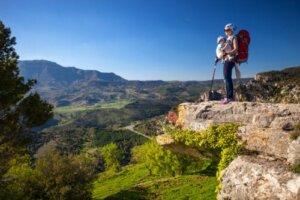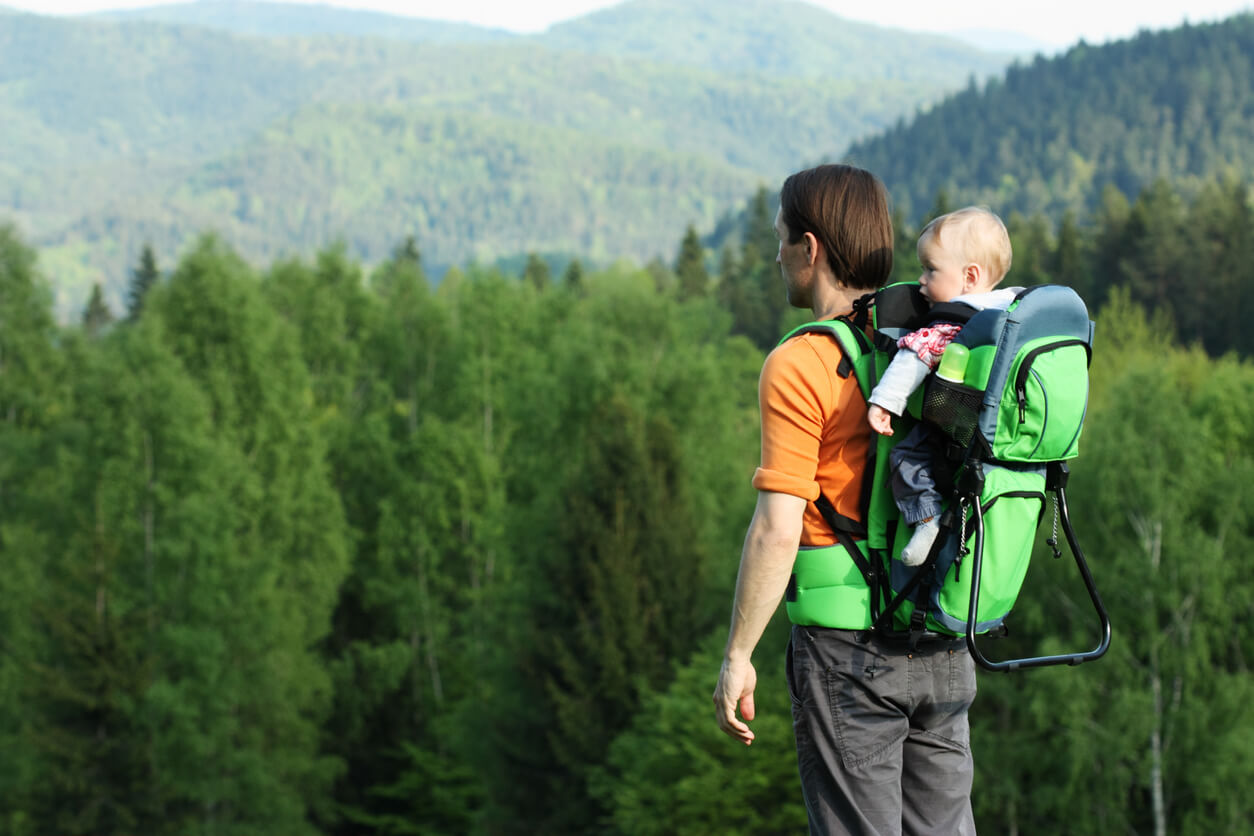4 Tips for Hiking with Your Baby

If you love to hike, the arrival of children in the family doesn’t have to be an impediment to maintaining this activity. The best thing, in these cases, is to incorporate the new member into nature walks and get them into the habit so that they learn to enjoy it. If you already want to plan your first outing together, don’t miss out on the best tips for hiking as a family with your baby.
Family hiking with your baby
The main idea is that you all spend a fun day together and also, that you take the opportunity to explore natural spaces, recharge your lungs with fresh air, and relax with this beautiful outdoor activity. Outings of this type offer great physical, psychological, and emotional benefits for people of any age.
“Study nature, love nature, stay close to nature. It will never fail you.”
-Frank Lloyd Wright-
4 tips for hiking with your baby
The first thing you have to do when you want to incorporate your baby into your walks is to plan everything carefully and well in advance. For this reason, we’ll leave you some tips that may be useful to you, especially if you’re a first-time mom or dad and this is your first experience. Take note!
1. Choose a good baby carrier
A baby carrier is an essential element to complete the journey, as it works both as transport and as protection for your little one. Models may vary, but basically, you want to make sure it’s ergonomic, of good quality, and has strong fasteners.
You may be interested in: Key Recommendations for Safe Babywearing
According to the age of the child, it’s best to carry them in the following way:
- Up to 6 months: Transport the baby in a front carrier, with them facing toward you. This type of design allows the head to be well supported and for you to be aware of its general condition at all times.
- 6 to 12 months: When your child achieves a good upright position, you can move to a baby carrier onto your back. Ideally, your child’s belly is in contact with your back. Avoid carriers that have the baby facing outward.
Another mode of transport that you can use is a baby carrier, but only when it comes to easy and conditioned trails.

2. Choose a short and well-thought-out route
Hiking with your baby as a family implies a very meticulous preliminary planning of the route to be covered. The main thing is to take safety into account, therefore, avoid steep paths or dangerous reliefs where falls or slips may occur. It’s better to choose flat and well-signposted paths because you’re carrying extra weight and you’ll tire faster than usual.
Opt for simple, short routes or well-known trails for the first experiences. It’s key that you know where there are resting places and that you know the way back perfectly in case you need to return quickly. A circuit to go and return in a few hours is enough at the beginning.
For the choice of the route, another fact to take into account is the weather. Therefore, check the weather forecast before you leave and reschedule the crossing if it’s very windy or the temperatures are extreme.
3. Be sure to bring water or food
Carrying water is essential in this type of excursion and a good quantity must be carried.
Just for adults, between 50 to 75 ounces of water are needed, according to the recommendations of the Valencia Hiking Club. In fact, the experts on this site recommend drinking at least 7 ounces of fresh water every half hour, in order to avoid overheating. To this amount, you must add the ration for children.
For the baby, you also have to bring hot water to prepare their bottle. In the event that they already eat food, you’ll need a container that preserves solid food. It’s also a good idea to bring fruit or any foods that serve as a healthy snack, such as cereal or homemade cookies.
4. Bring along the essentials for your baby: Wipes, a change of clothes, diapers, food…
Review the elements of the backpack before leaving, as it’s key that you don’t forget the essentials. We’ll remind you of the fundamentals:
- Hygiene: Wipes, diapers, changing mat, towel.
- Warm clothes: a change with long sleeves and long legs, a blanket, a hat, two pairs of socks.
- An extra change of light clothing.
- Protection: Disinfectant gel, sunscreen, umbrella, mosquito repellent.
Always remember to bring bags to bring back waste, such as leftover food, diapers, wipes, among others.

Let’s all have fun together!
Going hiking as a family is an experience to fully enjoy. For adults, it’s easy to become enraptured by a landscape and the silence of nature. But keep in mind that children need a little more fun to have a good time.
Avoid reaching this situation and plan stops along the way so that you can take the babies out of the backpacks, tell the children stories, and suggest games for them to play while they all walk along the path together. After all, the experience lends itself to talks, laughter, and the enjoyment of a valuable and unique moment.
The idea of hiking as a family with your baby is to make it an entertaining outing, so that your little one gradually adapts to this type of excursion and soon becomes a great outdoor adventurer. You’ll see that in time, they’ll be eager to repeat the journey when they return home!
If you love to hike, the arrival of children in the family doesn’t have to be an impediment to maintaining this activity. The best thing, in these cases, is to incorporate the new member into nature walks and get them into the habit so that they learn to enjoy it. If you already want to plan your first outing together, don’t miss out on the best tips for hiking as a family with your baby.
Family hiking with your baby
The main idea is that you all spend a fun day together and also, that you take the opportunity to explore natural spaces, recharge your lungs with fresh air, and relax with this beautiful outdoor activity. Outings of this type offer great physical, psychological, and emotional benefits for people of any age.
“Study nature, love nature, stay close to nature. It will never fail you.”
-Frank Lloyd Wright-
4 tips for hiking with your baby
The first thing you have to do when you want to incorporate your baby into your walks is to plan everything carefully and well in advance. For this reason, we’ll leave you some tips that may be useful to you, especially if you’re a first-time mom or dad and this is your first experience. Take note!
1. Choose a good baby carrier
A baby carrier is an essential element to complete the journey, as it works both as transport and as protection for your little one. Models may vary, but basically, you want to make sure it’s ergonomic, of good quality, and has strong fasteners.
You may be interested in: Key Recommendations for Safe Babywearing
According to the age of the child, it’s best to carry them in the following way:
- Up to 6 months: Transport the baby in a front carrier, with them facing toward you. This type of design allows the head to be well supported and for you to be aware of its general condition at all times.
- 6 to 12 months: When your child achieves a good upright position, you can move to a baby carrier onto your back. Ideally, your child’s belly is in contact with your back. Avoid carriers that have the baby facing outward.
Another mode of transport that you can use is a baby carrier, but only when it comes to easy and conditioned trails.

2. Choose a short and well-thought-out route
Hiking with your baby as a family implies a very meticulous preliminary planning of the route to be covered. The main thing is to take safety into account, therefore, avoid steep paths or dangerous reliefs where falls or slips may occur. It’s better to choose flat and well-signposted paths because you’re carrying extra weight and you’ll tire faster than usual.
Opt for simple, short routes or well-known trails for the first experiences. It’s key that you know where there are resting places and that you know the way back perfectly in case you need to return quickly. A circuit to go and return in a few hours is enough at the beginning.
For the choice of the route, another fact to take into account is the weather. Therefore, check the weather forecast before you leave and reschedule the crossing if it’s very windy or the temperatures are extreme.
3. Be sure to bring water or food
Carrying water is essential in this type of excursion and a good quantity must be carried.
Just for adults, between 50 to 75 ounces of water are needed, according to the recommendations of the Valencia Hiking Club. In fact, the experts on this site recommend drinking at least 7 ounces of fresh water every half hour, in order to avoid overheating. To this amount, you must add the ration for children.
For the baby, you also have to bring hot water to prepare their bottle. In the event that they already eat food, you’ll need a container that preserves solid food. It’s also a good idea to bring fruit or any foods that serve as a healthy snack, such as cereal or homemade cookies.
4. Bring along the essentials for your baby: Wipes, a change of clothes, diapers, food…
Review the elements of the backpack before leaving, as it’s key that you don’t forget the essentials. We’ll remind you of the fundamentals:
- Hygiene: Wipes, diapers, changing mat, towel.
- Warm clothes: a change with long sleeves and long legs, a blanket, a hat, two pairs of socks.
- An extra change of light clothing.
- Protection: Disinfectant gel, sunscreen, umbrella, mosquito repellent.
Always remember to bring bags to bring back waste, such as leftover food, diapers, wipes, among others.

Let’s all have fun together!
Going hiking as a family is an experience to fully enjoy. For adults, it’s easy to become enraptured by a landscape and the silence of nature. But keep in mind that children need a little more fun to have a good time.
Avoid reaching this situation and plan stops along the way so that you can take the babies out of the backpacks, tell the children stories, and suggest games for them to play while they all walk along the path together. After all, the experience lends itself to talks, laughter, and the enjoyment of a valuable and unique moment.
The idea of hiking as a family with your baby is to make it an entertaining outing, so that your little one gradually adapts to this type of excursion and soon becomes a great outdoor adventurer. You’ll see that in time, they’ll be eager to repeat the journey when they return home!
All cited sources were thoroughly reviewed by our team to ensure their quality, reliability, currency, and validity. The bibliography of this article was considered reliable and of academic or scientific accuracy.
- Fundación de Ferrocarriles de España (s/f). V.V.del mar. [Internet] Consultado el 28-03-2022. Disponible en: https://www.viasverdes.com/itinerarios/itinerario.asp?id=45
- https://www.lavanguardia.com/estilos-de-vida/20130614/54375609720/los-beneficios-de-la-naturaleza-para-los-ninos.html
- https://www.nationalgeographic.es/familia/2020/05/estos-son-los-beneficios-de-la-naturaleza-para-los-ninos
- Manil Raga (2016) Senderismo, montañismo e hidratación. [Internet] Consultado el 28-03-2022. Disponible en: https://clubsenderismodevalencia.club/senderismo-montanismo-e-hidratacion/#:~:text=As%C3%AD%20que%20en%20tus%20salidas,tomases%20un%20vaso%20de%20agua).
This text is provided for informational purposes only and does not replace consultation with a professional. If in doubt, consult your specialist.








